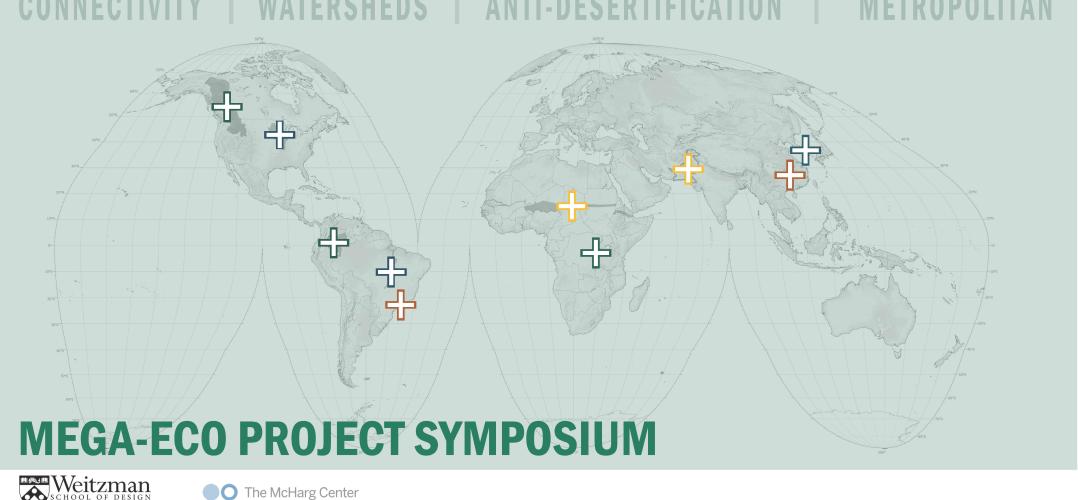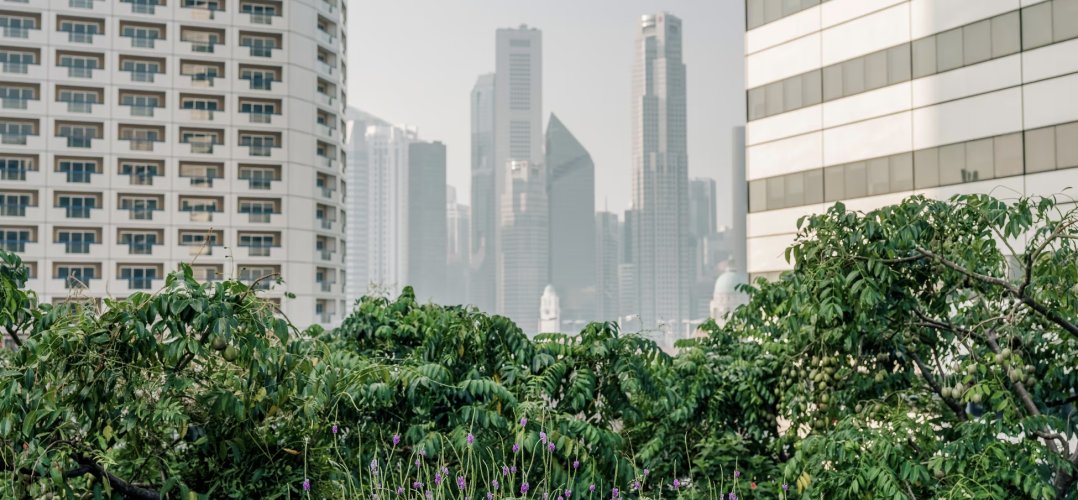Join our mailing list and receive invitations to our events and updates on our research in your inbox.
News + Events

Stream 'Landscape Futures' on YouTube
On September 27 and 28, 2024, the Department of Landscape Architecture presented Landscape Futures: Centennial of the Department of Landscape Architecture. The program included keynotes from James Corner (MLA’86) and Anne Whiston Spirn (MLA’74), as well as three panels moderated by landscape architecture faculty, all of which can be streamed on YouTube.
The Naturalist
With Jared Farmer, Sally Willig, Tessa Lowinske Desmond
Moderated by Sean Burkholder Jared Farmer, PhD, is the Walter H. Annenberg Professor of History at the University of Pennsylvania’s School of Arts and Sciences. Sally Willig, PhD, is a lecturer and program advisor in the Master of Environmental Studies program at the University of Pennsylvania’s College of Liberal and Professional Studies and Weitzman’s Department of Landscape Architecture. Tessa Lowinske Desmond is a research specialist in the School of Public and International Affairs at Princeton University, where she directs The Seed Farm at Princeton. Sean Burkholder is the Andrew Gordon Assistant Professor of Landscape Architecture at the Weitzman School of Design.
The Astronaut
With M. Christine Boyer (MS’64), Andrew Zolli , Alvin D. Harvey
Moderated by Azzurra Cox
M. Christine Boyer, PhD, is the William R. Kenan, Jr. Professor of Architecture and Urbanism at Princeton University’s School of Architecture, where she directs the undergraduate urban studies certificate program. Andrew Zolli is Chief Impact Officer at Planet, a space and AI organization that has deployed the largest constellation of Earth-observing satellites in history. Alvin D. Harvey, PhD, is Diné of the Navajo Nation and a postdoctoral fellow at MIT’s Department of Aeronautics and Astronautics, with a focus on Indigenous Research Methodologies and Methods. Azzurra Cox is an assistant professor of landscape architecture at the Weitzman School of Design.
The Household of Nature
With Sonja Dümpelmann, Lydia Kallipoliti, Rob Holmes
Moderated by Nicholas Pevzner (MLA’09)
Sonja Dümpelmann is Professor and Chair of Environmental Humanities at the Ludwig Maximilian University of Munich, where she co-directs the Rachel Carson Center for Environment and Society. Lydia Kallipoliti is an associate professor and director of the Master of Science in Advanced Architectural Design program at Columbia University’s Graduate School of Architecture, Planning, and Preservation. Rob Holmes is an associate professor and chair of the undergraduate landscape architecture program at Auburn University, where he leads the Landscape Infrastructure Design Lab. Nicholas Pevzner is an assistant professor of landscape architecture at the Weitzman School of Design.

"Essential Documentation." Adaptive Reuse in Latin America: Cultural Identity, Values and Memory
Adaptive reuse in Latin America in 2023 is a practice that focuses on preserving cultural identity, values, and memory through the renovation and repurposing of historical buildings and structures. This approach aims to maintain a strong connection to the region's rich cultural heritage and traditions while promoting sustainability and economic development. It involves converting old, often neglected buildings into new, functional spaces, such as museums, community centers, or housing, which celebrate and preserve the history and identity of the area. Adaptive reuse is a means of breathing new life into architectural gems, keeping them relevant for future generations, and maintaining a sense of cultural continuity in the rapidly changing urban landscapes of Latin America.

MEGA-ECO: A Symposium on Very Large-Scale Landscape Projects
For nearly a century, a new breed of landscape infrastructure megaproject has gone unrecognized, and is now proliferating, according to the organizers of a public symposium at the University of Pennsylvania Stuart Weitzman School of Design set for October 5, 2023. These projects are designed to address biodiversity loss, land degradation, and climate change while improving living conditions for the Earth’s eight billion human inhabitants. Representing trillions of dollars in potential investments, can they deliver the ecological transformation they promise?
MEGA-ECO: A Symposium on Very Large-Scale Landscape Projects brings together designers and land managers for ecological restoration megaprojects in China, Pakistan, Brazil, Africa, Korea, Saudi Arabia, Canada, and the US to explore cross-border approaches to connectivity, anti-desertification, watersheds, and metropolitan development. They include representatives of the World Wildlife Fund, the International Union for the Conservation of Nature, and the Center for Large Landscape Conservation, among others, who will discuss the Four Major Rivers Restoration Project (China); Forest Conservation in the Heart of the Colombian Amazon; Great Green Wall Initiative (Africa); São Paulo Greenbelt and Biosphere Reserve (Brazil); Sponge Cities Initiative (China); Upper Mississippi River Restoration Program (US); Upscaling Green Pakistan; and Yellowstone to Yukon (North America).
The program opens with a keynote talk by author Tony Hiss, co-creator of the half-earth movement (50x50) and visiting scholar at the Wagner School of Public Service, New York University.
The symposium is organized into four sessions, with presentations from each project representative followed by a discussion with expert panelists:
- Keith Bowers, Landscape Architect and Founder, Biohabitats
- Dr. Gary Tabor, Founder and Director, Center for Large Landscape Conservation
- Dr. Emmanuelle Cohen-Shachem, Nature-based Solutions, Thematic Lead, International Union for Conservation of Nature
- David Kuhn, Lead, Corporate Resilience, World Wildlife Fund
- Tyra Northwest, Traditional Land Use Lead, Samson Cree Nation, and co-founder, International Buffalo Relations Institute
Panel 1: Connectivity
- Dr. Jodi Hilty, Chief Scientist and President, Yellowstone to Yukon (Y2Y)
- Dominique Bikaba, Founding Member and Executive Director, Strong Roots Gorilla Corridor
- Ana Maria Gonzalez Velosa, Amazon Sustainable Landscapes Program Coordinator: Team leader, World Bank
- Andrea Fernanda Calderón, Technical Liaison of the Natural Heritage Project, North East Amazon Environmental and Sustainable Development Corporation (CDA), Proyecto Corazón de la Amazonia
Panel 2: Anti-Desertification
- Dr. Elvis Paul Nfor Tangem, Coordinator of the Great Green Wall Initiative
- Faiz Ali Khan, National Director, Upscaling Green Pakistan (formerly the Ten Billion Tree Tsunami Programme)
Panel 3: Watersheds
- Ben Valks, Creator/Visionary of the Araguaia Biodiversity Corridor
- Marshall Plumley, Regional Program Manager, Upper Mississippi River Restoration Program
- Yongjun Jo, Landscape Architect
Panel 4: Metropolitan Projects
- Hexing Chang, Associate Principal, Turenscape
- Rodrigo Victor, Professor, University of São Paulo
Concluding remarks will be delivered by Matthijs Bouw, Associate Professor of Practice at the Weitzman School of Design.
MEGA-ECO is presented by The Ian L. McHarg Center for Urbanism and Ecology and Penn Global, and is organized by Rob Levinthal, PhD candidate in the Department of City & Regional Planning, and Richard Weller, professor of landscape architecture.
MEGA-ECO builds on the 2019 publication Design With Nature Now, a re-assessment of the legacy of Ian McHarg’s landmark 1969 book Design With Nature which was co-edited by Weller along with Penn faculty members Frederick Steiner, dean and Paley Professor; Karen M’Closkey, associate professor of landscape architecture; and Billy Fleming, Wilks Family Director at The McHarg Center.
The public symposium on October 5 is followed by an invite-only roundtable on October 6. Admission to the symposium is free and open to the public with advance registration.
Link to register: https://www.eventbrite.com/e/mega-eco-project-symposium-tickets-7087385…

Denser and greener cities: Green interventions to achieve both urban density and nature.
- Green spaces in urban areas—like remnant habitat, parks, constructed wetlands, and street trees—supply multiple benefits.
- Many studies show green spaces in and near urban areas play important roles harbouring biodiversity and promoting human well-being. On the other hand, evidence suggests that greater human population density enables compact, low-carbon cities that spare habitat conversion at the fringes of expanding urban areas, while also allowing more walkable and livable cities. How then can urban areas have abundant green spaces as well as density?
- In this paper, we review the empirical evidence for the relationships between urban density, nature, and sustainability. We also present a quantitative analysis of data on urban tree canopy cover and open space for United States large urbanized areas, as well as an analysis of non-US Functional Urban Areas in OECD countries.
- We found that there is a negative correlation between population density and these green spaces. For Functional Urban Areas in the OECD, a 10% increase in density is associated with a 2.9% decline in tree cover. We argue that there are competing trade-offs between the benefits of density for sustainability and the benefits of nature for human well-being. Planners must decide an appropriate density by choosing where to be on this trade-off curve, taking into account city-specific urban planning goals and context.
- However, while the negative correlation between population density and tree cover is modest at the level of US urbanized areas (R2 = 0.22), it is weak at the US Census block level (R2 = 0.05), showing that there are significant brightspots, neighbourhoods that manage to have more tree canopy than would be expected based upon their level of density. We then describe techniques for how urban planners and designers can create more brightspots, identifying a typology of urban forms and listing green interventions appropriate for each form. We also analyse policies that enable these green interventions illustrating them with the case studies of Curitiba and Singapore.
- We conclude that while there are tensions between density and urban green spaces, an urban world that is both green and dense is possible, if society chooses to take advantage of the available green interventions and create it.